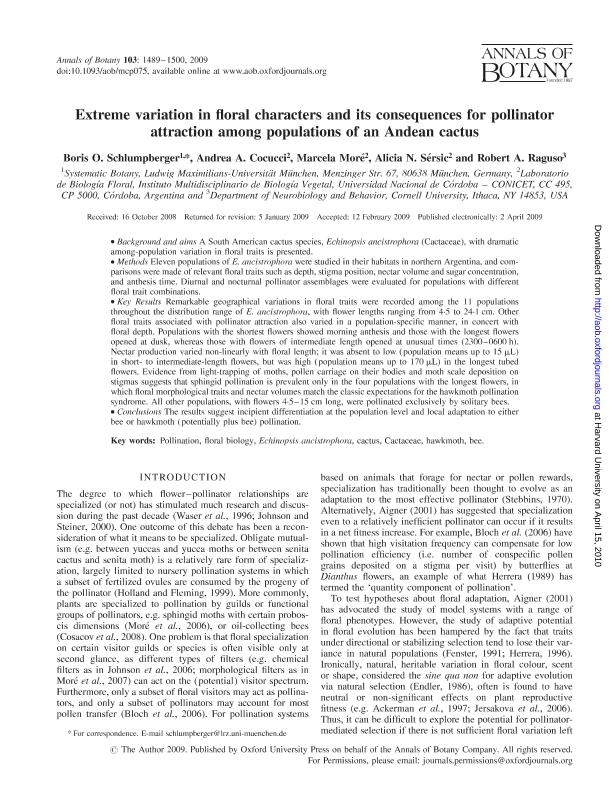Mostrar el registro sencillo del ítem
dc.contributor.author
Schlumpberger, Boris O.
dc.contributor.author
Cocucci, Andrea Aristides

dc.contributor.author
More, Marcela

dc.contributor.author
Sersic, Alicia Noemi

dc.contributor.author
Raguso, Robert A.
dc.date.available
2017-09-14T20:03:55Z
dc.date.issued
2009-04
dc.identifier.citation
Schlumpberger, Boris O.; Cocucci, Andrea Aristides; More, Marcela; Sersic, Alicia Noemi; Raguso, Robert A.; Extreme variation in floral characters and its consequences for pollinator attraction among populations of an Andean cactus; Oxford University Press; Annals of Botany; 103; 9; 4-2009; 1489-1500
dc.identifier.issn
0305-7364
dc.identifier.uri
http://hdl.handle.net/11336/24299
dc.description.abstract
Background and aims: A South American cactus species, Echinopsis ancistrophora (Cactaceae), with dramatic among-population variation in floral traits is presented. Methods: Eleven populations of E. ancistrophora were studied in their habitats in northern Argentina, and comparisons were made of relevant floral traits such as depth, stigma position, nectar volume and sugar concentration, and anthesis time. Diurnal and nocturnal pollinator assemblages were evaluated for populations with different floral trait combinations. Key Results: Remarkable geographical variations in floral traits were recorded among the 11 populations throughout the distribution range of E. ancistrophora, with flower lengths ranging from 4.5 to 24.1 cm. Other floral traits associated with pollinator attraction also varied in a population-specific manner, in concert with floral depth. Populations with the shortest flowers showed morning anthesis and those with the longest flowers opened at dusk, whereas those with flowers of intermediate length opened at unusual times (2300–0600 h). Nectar production varied non-linearly with floral length; it was absent to low (population means up to 15 mL) in short- to intermediate-length flowers, but was high (population means up to 170 mL) in the longest tubed flowers. Evidence from light-trapping of moths, pollen carriage on their bodies and moth scale deposition on stigmas suggests that sphingid pollination is prevalent only in the four populations with the longest flowers, in which floral morphological traits and nectar volumes match the classic expectations for the hawkmoth pollination syndrome. All other populations, with flowers 4.5–15 cm long, were pollinated exclusively by solitary bees. Conclusions: The results suggest incipient differentiation at the population level and local adaptation to either bee or hawkmoth (potentially plus bee) pollination.
dc.format
application/pdf
dc.language.iso
eng
dc.publisher
Oxford University Press

dc.rights
info:eu-repo/semantics/openAccess
dc.rights.uri
https://creativecommons.org/licenses/by-nc-sa/2.5/ar/
dc.subject
Echinopsis
dc.subject
Pollination
dc.subject
Longue Tongue Hawkmoth Pollination
dc.subject.classification
Bioquímica y Biología Molecular

dc.subject.classification
Ciencias Biológicas

dc.subject.classification
CIENCIAS NATURALES Y EXACTAS

dc.title
Extreme variation in floral characters and its consequences for pollinator attraction among populations of an Andean cactus
dc.type
info:eu-repo/semantics/article
dc.type
info:ar-repo/semantics/artículo
dc.type
info:eu-repo/semantics/publishedVersion
dc.date.updated
2017-09-11T17:53:33Z
dc.identifier.eissn
1095-8290
dc.journal.volume
103
dc.journal.number
9
dc.journal.pagination
1489-1500
dc.journal.pais
Reino Unido

dc.journal.ciudad
Oxford
dc.description.fil
Fil: Schlumpberger, Boris O.. Ludwig Maximilians Universitat; Alemania
dc.description.fil
Fil: Cocucci, Andrea Aristides. Consejo Nacional de Investigaciones Científicas y Técnicas. Centro Científico Tecnológico Conicet - Córdoba. Instituto Multidisciplinario de Biología Vegetal. Universidad Nacional de Córdoba. Facultad de Ciencias Exactas Físicas y Naturales. Instituto Multidisciplinario de Biología Vegetal; Argentina
dc.description.fil
Fil: More, Marcela. Consejo Nacional de Investigaciones Científicas y Técnicas. Centro Científico Tecnológico Conicet - Córdoba. Instituto Multidisciplinario de Biología Vegetal. Universidad Nacional de Córdoba. Facultad de Ciencias Exactas Físicas y Naturales. Instituto Multidisciplinario de Biología Vegetal; Argentina
dc.description.fil
Fil: Sersic, Alicia Noemi. Consejo Nacional de Investigaciones Científicas y Técnicas. Centro Científico Tecnológico Conicet - Córdoba. Instituto Multidisciplinario de Biología Vegetal. Universidad Nacional de Córdoba. Facultad de Ciencias Exactas Físicas y Naturales. Instituto Multidisciplinario de Biología Vegetal; Argentina
dc.description.fil
Fil: Raguso, Robert A.. Cornell University; Estados Unidos
dc.journal.title
Annals of Botany

dc.relation.alternativeid
info:eu-repo/semantics/altIdentifier/doi/https://doi.org/10.1093/aob/mcp075
dc.relation.alternativeid
info:eu-repo/semantics/altIdentifier/url/https://academic.oup.com/aob/article-lookup/doi/10.1093/aob/mcp075
Archivos asociados
